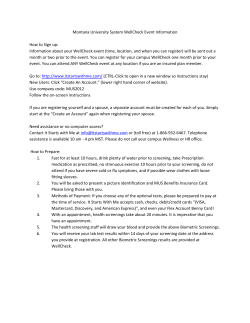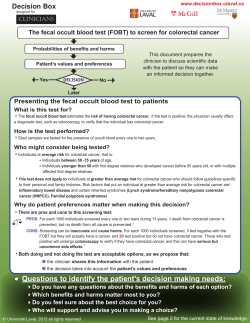
How to Increase Preventive Screening Rates in Practice: Toolbox and Guide
How to Increase Preventive Screening Rates in Practice: An Action Plan for Implementing A Primary Care Clinician’s Evidence-Based Toolbox and Guide We gratefully acknowledge the contributions of the following individuals: Dr. Terri Ades, DNP, FNP-BC, AOCN Durado Brooks, MD, MPH Edwin Diaz Mary Doroshenk, MA Ted Gansler, MD Cynthia Gelb Carmen Guerra, MD Djenaba Joseph, MD, MPH Debbie Kirkland Dorothy Lane, MD, MPH Barbara Cebuhar Mona Sarfaty, MD, MPH Robert Smith, PhD Michelle Tropper, MPH Gregory Walker, MBA Richard Wender, MD Claire Weschler, MSEd Colorectal Cancer • The third most common cancer in U.S. and the second deadliest – 141,000 new cases expected this year – More than 49,000 deaths nationwide • 1.1 million Americans living with colorectal cancer • Death rates have fallen steadily over the past 20 years Trends in Colorectal Cancer Mortality Rates by Race/Ethnicity and Sex, 1975‐2007 Trends in CRC Research suggests that observed declines in CRC incidence and mortality rates are due in large part to: • Screening and polyp removal, preventing progression of polyps to invasive cancers – NEJM study Feb 2012 showed polyp removal associated with 53% lower risk of CRC death • CRC treatment advances • Screening detecting cancers at earlier, more treatable stages Benefits of Screening Survival Rates by Disease Stage* 5-yr Survival 100 90 80 70 60 50 40 30 20 10 0 89.8% 67.7% 10.3% Lo cal Reg io n al Distan t St age of Det ect ion *1996 - 2003 Question: Do PCP’s screen their patients for CRC? Answer: Yes, 98% already do. But often done in a haphazard, uncoordinated fashion Results in some at‐risk patients getting screened, others overlooked (Klabunde, et. al., Prev Med 2003) “Action Plan” Toolkit Version Eight page guide introduces clinicians and staff to concepts and tools provided in the full Toolkit Contains links to the full Toolkit, tools and resources Not colorectal‐specific; practical, action‐oriented assistance that can be used in the office to improve screening rates for multiple cancer sites (colorectal, breast and cervical) Available at http://nccrt.org/about/providereducation/crc-clinician-guide/ Communication Make a Recommendation Essential #1 Essential #1 Determine the screening messages you and your staff will share with patients. Explore how your practice will assess a patient’s risk status and receptivity to screening. Tools for Your Practice Essential #1: Make a Recommendation • CRC Screening Options and Patient Readiness • Risk Assessment Why Not Colonoscopy for All? • Screening rates are disappointingly low • Patient preference – Many individuals don’t want an invasive test or a test that requires a bowel prep – Some may not have access to the invasive tests due to lack of coverage or local resources • Greater patient requirements for successful completion of tests that detect both polyps and cancers – Endoscopic and radiologic exams require a bowel prep and an office or facility visit • Evidence does not support “best test” or “gold standard” – Colonoscopy misses 5 – 10% of significant lesions in expert settings – Questions about efficacy in proximal colon – Higher potential for patient injury than other tests – Test performance is highly operator dependent High Quality Stool Testing • • • • CRC screening by FOBT should be performed with high‐sensitivity FOBT ‐ either FIT or a highly sensitive gFOBT (such as Hemoccult SENSA). – Older, less sensitive guiaic tests (such as Hemoccult II) should not be used for CRC screening. Tests should be repeated yearly In‐office FOBT is essentially worthless as a screening tool for CRC and must be strongly discouraged. All positive screening tests should be evaluated by colonoscopy Sample Tools for Your Practice Develop a Screening Policy Essential #2 Create a standard course of action for screenings, document it, and share it. Essential #2 Compile a list of screening resources and determine the screening capacity available in your community. Tools for Your Practice Essential #2: Develop a Screening Policy • Screening Policy and Office Visits • CRC Patient Education Materials Sample Screening Algorithm Sample Tools for Your Practice Assess Risk: Personal & Family History Average risk = No family history of CRC or adenomatous polyp < 50 years Increased or high risk based on family history Increased or high risk based on personal history > 50 years Adenoma Do not screen CRC Screen IBD Surveillance Colonoscopy High Risk: Germline Syndrome HNPCC or FAP Adenoma or cancer If positive, diagnosis by colonoscopy Screening colonoscopy, genetic testing, and other cancer screening as appropriate Options Tests That Find Polyps and Cancer Flexible sigmoidoscopy every 5 years, or Colonoscopy every 10 years Double-contrast barium enema every 5 years, or CT colonography (virtual colonoscopy) every 5 years Tests That Primarily Find Cancer Yearly fecal occult blood test (gFOBT) *, or Yearly fecal immunochemical test (FIT) *, or Stool DNA test (SDNA), interval uncertain Screen with colonoscopy 10 years before youngest relative or age 40 *The multiple stool take-home test should be used. One test done by the doctor in the office is not adequate for testing. The tests that are designed to find both early cancer and polyps are preferred if these tests are available and the patient is willing to have one of these more invasive tests. *This version of stage theory was adapted from the work of RE Myers. Patient Education Get Tested For Colon Cancer: Here's How." 7-minute video discusses and demonstrates options for colorectal cancer screening, including potential benefits and limitations of each method. Available as DVD, or you can refer patients to the URL to view from their personal computer. Be Persistent with Reminders Essential #3 Essential #3 Determine how your practice will notify patient and physician when screening and follow up is due. Ensure that your system tracks test results and uses reminder prompts for patients and providers. Tools for Your Practice Essential #3: Be Persistent • Reminder Systems • Tracking Information Office Wall Chart Screening guidelines for Breast, Cervical, Colon, Prostate and other cancers General lifestyle/prevention Tobacco cessation Healthy diet Weight, etc English and Spanish Reminder Fold‐Over Postcard ©2009 American Cancer Society, Inc. No.0052.19 ©2009 American Cancer Society, Inc. No.0052.19 Measure Practice Progress Essential #4 Essential #4 Discuss how your screening system is working during regular staff meetings, and make adjustments as needed. Have staff conduct a screening audit, or contact a local company that can perform such a service. Saving Lives Through Preventive Cancer Screening ADJUST PLAN STUDY ACT Tools for Your Practice Essential #4: Measure Progress • Staff Feedback • Practice Performance Click on education drop down box Then select Maintenance of Certification Communication Saving Lives Through Preventive Cancer Screening Implement practice changes to achieve the Four Essentials. Take steps to identify and screen every age-appropriate patient. Involve your staff, and put office systems in place . Follow a continuous improvement model to develop and test changes to your screening system. Additional tools and resources to assist practices with increasing colorectal cancer screening can be found in the full version of the Toolkit. Available at www.nccrt.org and www.cancer.org/colonmd
© Copyright 2025





















